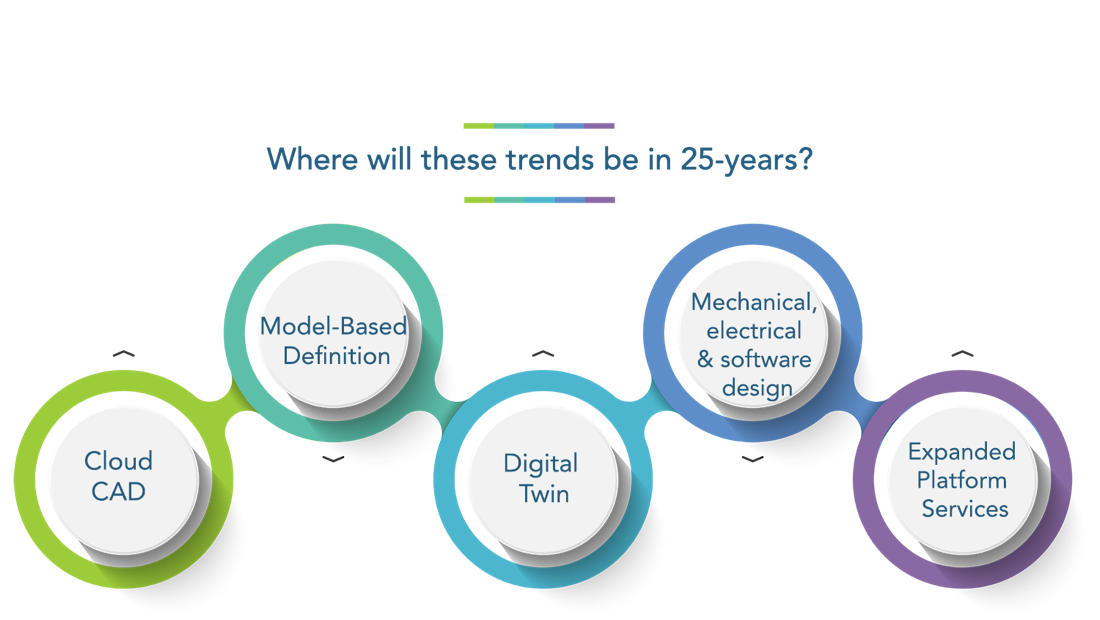I recently had the opportunity to embark on a mid-career sabbatical, affording me the chance to not only reflect on my 25-year career but also look forward and speculate on what the next 25 years may look like. Joining CIMdata is exciting but, at the same time, a little bit humbling, knowing that I am surrounded by some of the brightest minds in engineering software. I must admit I am the “youngster” on the team, and I am very focused on what the landscape might look like when I, too, have 40+ years of experience.
During my sabbatical, I spent a lot of time thinking about my career and deeply researching a few trends that I think will alter the engineering software ecosystem in the next quarter-century. Here are some of the topics I delved into:
Cloud CAD: There is a lot of excitement around cloud-based CAD, but it’s not without its naysayers. I can honestly say that the momentum towards cloud CAD feels a lot like the shift to Windows around 2000. I remember everybody saying it was impossible to run 3D on a Windows machine, but that seems to have worked out. But what about drawings? Well, that brings me to my next point.
Model-Based Definition (MBD): I know we have been talking about model-based definition for a very long time, yet I see light at the end of the tunnel. As supply chain, manufacturing, and even quality move towards increasingly digital systems, the vision of a model-based enterprise is more achievable than ever. As CAD and PLM increasingly move to the cloud, these models won’t be locked on a server somewhere. Our next generation of engineers won’t be drawing-focused, and, after all, isn’t a drawing just a collection of annotated, purpose-driven, saved views?
Digital Twin: It’s hard to discuss this as an emerging trend since it has been a big part of our vocabulary for so long that people are almost tuning out. However, let’s be honest – successful adoption is in its infancy, and there are big conversations to be had around it. It is on the roadmaps of most industrial companies, but it will be a long, hard time getting there with product data in siloed applications. This brings us to…
Convergence of mechanical, electrical, and software design: Again, this is not new, but this might change how discrete products are developed sooner rather than later. It’s no secret that the leading PLM solution providers are also seeing this and investing in ALM tools. Many traditional PLM systems grew out of the need to manage 3D CAD, and they are certainly good at it, but does it make sense for one group to work against ECOs and another to work in sprints, hoping the product will come together magically?
Expanded Platform Services: Most PLM companies have been working diligently but quietly to develop platform services that someday will enable the integration of the product development technology stack for both cloud applications and legacy on-premises software systems. It is understandably difficult to articulate the benefits of these platforms because they don’t do anything themselves. However, in the future, they will serve as the glue that holds your digital ecosystem together, making an actual model-based enterprise possible. These unsung heroes are still emerging, but they will be differentiators.

None of this is revolutionary thought leadership, and change is incremental. In another 25 years, the way the industry develops products will look very different, and I look forward to seeing how it continues to evolve over the decades.
Stay tuned for updates on my journey at CIMdata, and please let me know your thoughts on these topics. I look forward to engaging in a dialogue with you as we embark on this exciting new chapter together!
Warm regards.


Be the first to post a comment.